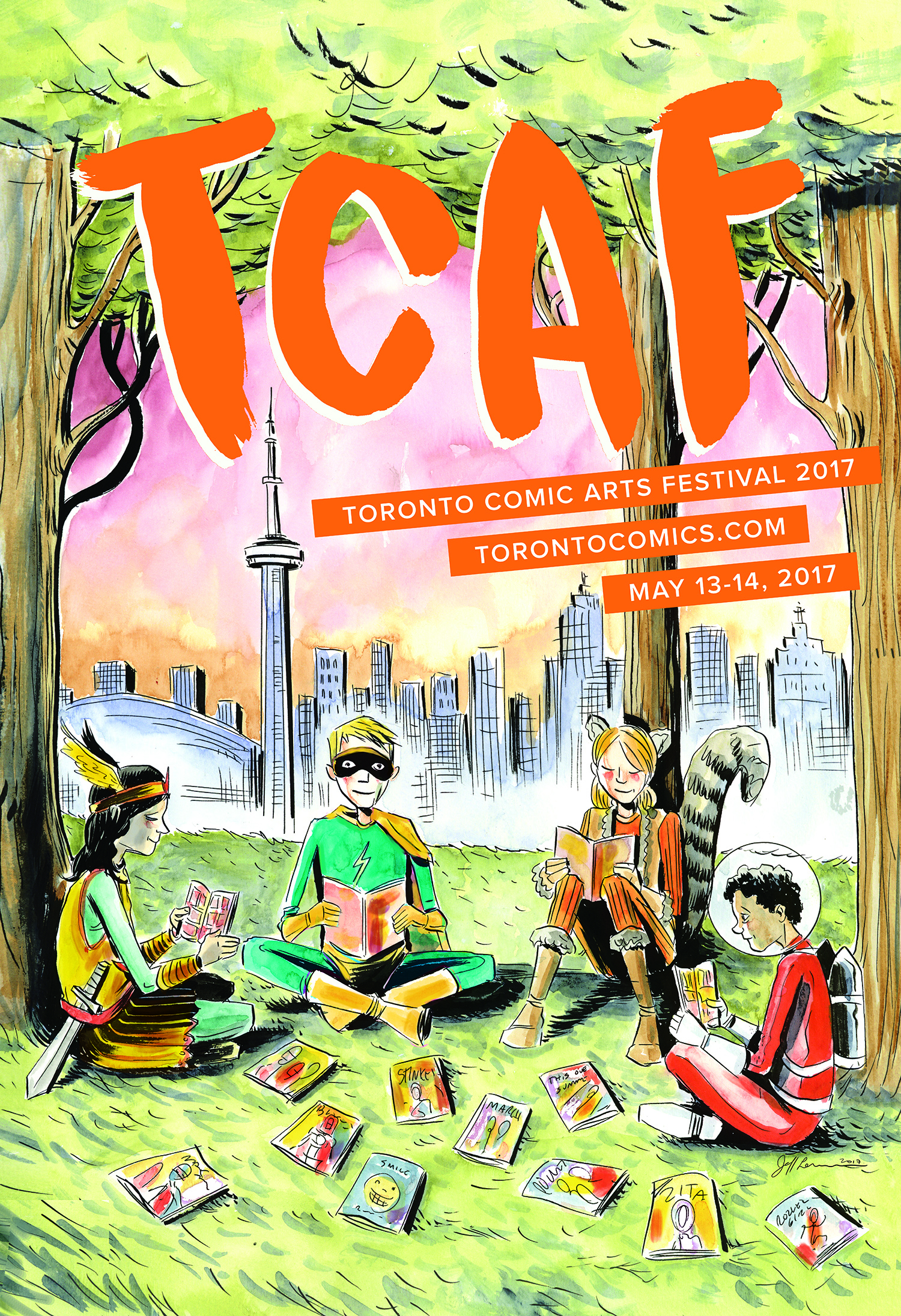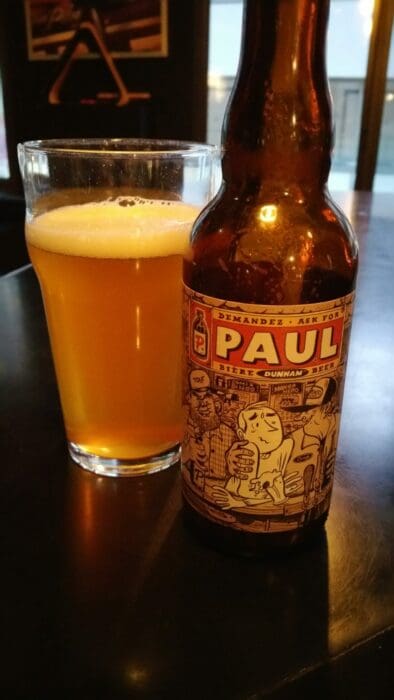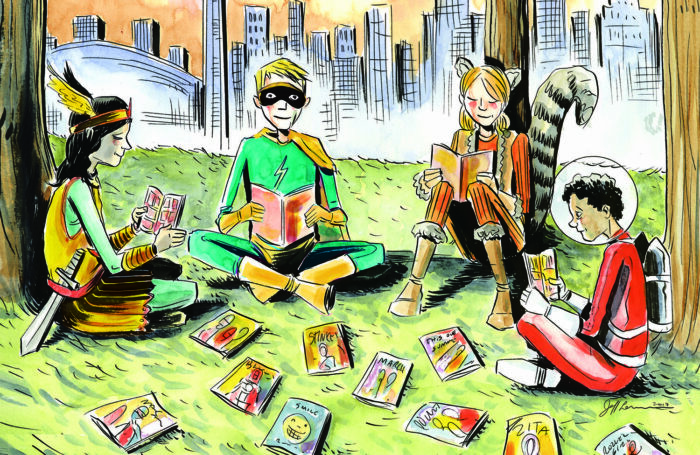
Once a year, the Toronto Reference Library transforms into comics nirvana – and despite my love of graphic novels and comics, I’d never been. The Toronto Comic Arts Festival is one of those many events I’d managed to never quite get to and having spent a couple days wandering the fest this year, I can’t fathom how I missed it for so long. There were some incredible things to see and do, and below I’ve included my highlight, lowlight, and honourable mention of the festival, along with an account of what the festival feels like to a first timer. If you have any interest in graphic novels, comics, hell almost anything, there’s something for you at TCAF. Read on and hopefully I’ll see you in the mob at 2018!
My First TCAF: Wandering the Festival
Clutching my one purchase, I made a break for the door. The crowd was intensifying, I’d already missed one panel, due to over-crowding, and my ever-present backpack was proving to be an increasingly deadly hindrance. I nodded to the security guard, who from his thousand-yard-stare as people streamed out of the building, looked like he was having the worst day of his year, and ejected onto Yonge Street. The subway is down, because Toronto, so there’s a mob, both headed in and out of the festival, as well as realizing how late they’re going to be because Toronto. I quickly fight my way past, ducking onto a side road to catch my breath.
TCAF is, in a word, overwhelming.
I’m a longtime vetran of Fan Expo and honestly, this isn’t that different, but what is different is the content: here, there are tonnes of creators, ready, willing, and excited to tell you about their work, which you can buy on site, get signed, and walk away with a neat story about. In theory, this is the most perfect possible way to get into a new writers’ work: let them tell you about it! If, like me, your main exposure to graphic novels and comics is from the big houses (Marvel, DC, Image, Dark Horse, etc), TCAF is absolutely the place to be to get, for lack of better term, artisanal comics. Many of the books on sale are self published, or limited run, and from my wanderings I can guarantee there’s something for you, no matter what your interest. I saw incredible biographies, historical epics, inventive genre books, outlandish erotica, all in a variety of tones, styles, and forms.
The only problem is, the place is packed.
Leaning hard on the politest side of the Canadian spectrum, I hate taking up space and inconveniencing people, but you pretty much have to be willing to plant your flag in order to get near a booth, let alone have the conversation to learn about the book. Like anything, the crowd ebbs and flows, and sometimes you get luck and can swoop in, but for the most part, patience is key. And unfortunately, it’s damn hard to have patience in the mob. Think of the worst rush hour you’ve experienced and add more backpacks.; that’s pretty much what you’re dealing with.
Unfortunately, this runs contrary to my above statement about how TCAF functions: it’s very hard, I found, to figure out what I wanted to learn more about, let alone get close enough to ask about it. So, while at Fan Expo or somesuch, I am generally familiar with the works on offer, here, I found myself having to literally judge every book by its cover, which as you know can be a tricky proposition (especially as you’re bobbing up over the crowd to see what’s on the table).
Ultimately, I learned how little I know about Toronto and indie comics, which bummed me out. I’ve sought out those things in theatre, film, food, music, comedy, but I’d seriously neglected comics (with the exception of Chester Brown, who even then, is a famous rockstar in the indie Toronto comic sphere). I found myself getting increasingly anxious about my own ignorance (and the danger of just buying at random; there’s a feeding frenzy vibe to festivals that leads you to go nuts in a way you never would in a local shop. Imagine buying everything that looked vaguely intriguing at Indigo, for example).
So, I settled on a solution: the one book I bought was called Yonge at Heart Volume 4 of Toronto Comics. It’s an anthology of local comics and a sampler of what’s available, so next year, I’ll know which tables I need to muscle my way over to.
And in the meantime, I have something great to read while I wait for the replacement bus.
Because, Toronto.
Highlight: BLACK DOG: The Dreams of Paul Nash
This year, TCAF has a very, very special presentation: renowned comic artist/writer Dave McKean (probably most famous for his mind-bending Sandman covers, for Grant Morrison’s Arkham Asylum, or for Coraline) teamed up with baritone/cellist Matthew Sharp and violinist Claire Haythornwaite to perform his graphic novel. The result is a trippy hybrid of visual art, opera, music, and acting as the three performers alternate between speaking the text, singing the text, and scoring the visuals, which are presented in a guided ‘motion comic’ format, that guides our view of the projected panels in a highly cinematic format. It’s unlike anything I’ve ever seen, and a brilliant example of how artistic forms can compliment each other to create a wholly new experience.
Ultimately, BLACK DOG is an impressionistic fever dream, made all the more haunting by the operatic delivery of Sharp and the simple, honest performance of text by the three performers. When I read the graphic novel afterwards, I was shocked at how fully they were able to realize it on stage and how lucky I was to see it.
BLACK DOG tells the story of artist Paul Nash, whose paintings of his experiences of World War One are visceral and convey great depth of the horror and scope of the conflict through an artists’ lens. McKean became fascinated with Nash and decided to tell his life story, juxtaposed against his war experiences as Nash is haunted by dreams of a Black Dog, leading him to examine his upbringing and his time at war. In performance, Sharp sang the dreams, his deep, resonate voice underscored by the live music performed by him, Haythornewaite and McKean. The images are haunting enough, but when backed by the echoing voice of Sharp the dreamscape comes to life. In retrospect, this is how I imagine most McKean works sound. When outside the dreamscape, McKean and Sharp play most of the parts, as Nash recounts his experience of his parents, his schooling, and his childhood, as well as discussions with cultural and intellectuals at the outbreak of the war, and finally his conversations with doctors during recovery and fellow vets after the conflict.
This description is, I’m afraid, terribly reductive – McKean’s stuff is always difficult to approach from a purely intellectual perspective; the images and the way words weave in and out of them convey so much emotion it’s hard to describe them with any real accuracy. But, at it’s core, this is the story its telling: commissioned by 14-18 NOW, the UK’s WWI Centenary Art Commission for the Lakes International Comic Art Festival, where it premiered, BLACK DOG succeeds brilliantly in capturing the confusing, visceral nature of the Great War and is a valuable new document in the remembrance and understanding of the increasingly distant conflict.
As for the show, it’s a rare honour to get to see an author perform their story live, particularly in this style: in the age of Audible, we’ve got an embarrassment of riches when it comes to our access to writers’ reading their own work (for better or worse, depending on the writer), but to see a writer also perform music and act alongside their work is a truly magical experience. McKean has a soft, clear voice that lends itself well to his subject and carries the weight of having studied the man and his desire and drive to bring his story to life. Sharp is an excellent foil and the surprise of hearing Haythornewaite, playing Nash’s lifelong love and wife (as the performer is McKean’s, in real life) in the final scene was lovely. From a pure adaptation perspective, having three such performers is a gift: they play spectacularly, but speak with equal ease, confidence, and clarity. Coupled with the power of the images (and indeed, the space itself – Toronto’s grandiose Masonic Temple, former home of Electric Circus, amongst other things) creates an all-encompassing experience. Normally, I’m able to put thoughts about things like this to paper (digital or otherwise) pretty quickly, but I left BLACK DOG shaken. I was lucky enough to run into a friend, the incredibly talented performer Nigel Downer, right afterward and was happy to see the same impact reflected on his face that I knew was on mine; we both admitted that we needed time to process, rare amongst us graphic novel/performer-y types. It was that kind of thing: beautiful, haunting, and overwhelming.
Having long been a fan of Dave McKean, whom frequent collaborator Neil Gaiman recently described as his favourite artist to work with, it was an honour to get to experience his newest work in this form. In graphic novels, it’s always easy to feel that these authors and artists are untouchably distant; they exist in name –on-page, and in their work, but seeing them ply their trade live is a rarity. Ironically, McKean admits in the program notes, that he doesn’t want this production to the definitive version (which, I must admit, I will always consider it), stating:
“It was never supposed to be like this! Comics are vital in their own right. This is a unique medium…I want to hear Nash’s voice in my head. I want the images to quote from still imagery, and NOT to move. You, the reader, have to create the illusion when necessary.”
While I found I still gained this experience, I take McKean’s point: to make a static image move, to alter the way a reader encounters and processes the work (indeed, as viewer and listener, rather than reader), fundamentally alters the work itself. It’s an adaptation, and a damn good one – but an adaptation nevertheless. And for me, a spectacular blueprint for thinking about how to adapt a graphic novel without completely abandoning the form.
And what an honour to see the creator of the work himself do the adapting.
BLACK DOG: The Dreams of Paul Nash by Dave McKean is available from Dark Horse Publishing wherever graphic novels are sold (including Page and Panel, TCAF’s year-round home/store in the Toronto Reference Library).
Lowlight: Comics on Comics – trainwreck panel serves as a useful reminder that the moderator is all
It seldom comes to this, but about halfway into this panel, I scrawled in all caps: WHAT THE FUCK HE TURNED IT INTO A SEMINAR CLASS. Then I dropped my pen. I didn’t bother to recover it, there was nothing worth writing.
Sometimes at festivals like this, or Fan Expo, panels go to hell. This can be for a variety of reasons: tired/irritable/combatitive guests; annoying or pushy fans (ask any former cast member of Firefly: no matter how many times fans ask, the show still isn’t coming back); and sometimes, it’s a bad moderator.
Today, it was the latter: the Comics on Comics panel, was to be a discussion of writing comedic comics, featuring a pretty diverse cross-section of comedy, from single panel auto-biographical stuff, to Jonny Sun, better known for his weird-twitter persona Jomny Sun.
The problems began, when the well-meaning moderator started awkwardly asking guests up to answer ‘getting to know you questions’ like, “Pie or cake?” then being gently taken aback when he received one-word responses. He looked to have done little to no prep work, aside from writing down some of these prompts and the guests and audience were gently mortified. For context, the moderator is an academic, who certainly knows the comedy comic sphere, having published a deep dive book on Canadian comic artist Seth, but was much more concerned with obscure academic questions (“What is the difference between ‘funny’ and ‘jokey’?) which left the panellists generally vexed and mildly incredulous.
It was a painfully awkward affair from there, occasionally lightened by amusing anecdotes that were largely motivated by the guests themselves, as the moderator continued quipping about how badly the panel was going.
My all caps tirade landed around the time he started putting up one panel comics by other creators and asking the panellists “why they were funny.” It literally felt like a university seminar class…and the guests felt it too.
Finally, when he opened it to the floor, we had some decent discussion, with one question, “Have you tried any other types of comedy?” prompting the host to quip, “That’s a great question! He should have moderated the panel.” To which an audience member, speaking our collective truth, loudly stated, “Yes.”
The whole thing was a waste of time, made worse by how badly I felt for the panellists burning on stage (no fault of theirs), and the host constantly pointing out how badly it was going, though seemingly because he felt the guests weren’t playing ball (rather, his questions were closed; they demanded an answer, not a response. This is the death of dialogue, as it leaves it up to the guest to lead – a common, problematic interview tactic, that often has the inmates running the asylum).
The lesson: just because you are a subject expert does not mean you can moderate a panel. Like hosting a podcast or show, MC’ing an event, or interviewing someone, there is an art to it that is invisible if done well; if it’s done poorly, you end up getting lambasted in an article by a professional media trainer who writes for an entertainment website. Worse still, the potential for discussion and insight that drew the audience to the panel was wasted: if I wanted to audit a seminar class, I’m sure festival sponsor Sencea College would be happy to oblige.
 Honourable Mention: Demandex Paul Biere / Ask For Paul: The Official TCAF Beer
Honourable Mention: Demandex Paul Biere / Ask For Paul: The Official TCAF Beer
Beautiful, smooth drinking ‘Wild Pale Ale’ by Brasserie Dunham, 5.9%. Shares that slight, almost floral taste that characterizes a lot of Quebecois beer, but without the over-reliance on hops that has come to characterize a lot of Ontario craft beers. It’s a masterfully crafted pale ale; one that has a complex, but smooth flavour – craft, without sacrificing the spirit of the pale ale.
I’ve been trying to think of what Ontario beer I can draw a comparison to, but honestly it’s in a league of it’s own; the best I’ve come up with is a slightly smoother and more complex Amsterdam Cruizer Ale, but even that doesn’t quite work.
In a lot of ways, the flavour sums up the vibe here at TCAF; complex artistry presented approachably. It’s a comfortable sipping beer, but an elevated one. Just like a lot of the comics and graphic novels on display here; the creators and here and excited to talk to you about their art. The programming is diverse covering everything from writing through depression to a collective comic creation session for kids (on that note, the focus on and integration of children’s’ programming is stellar).
The label, illustrated by Michel Rabagliati, tells the tale of Paul’s night out at the Bar Deliverance, populated by colourful characters such as a hard case picking his nails with a knife, a lone banjo player, and a couple of truckers rocking TCAF hats that have taken a shying to Paul, pulling him awkwardly into the embrace of a joke as the bartender grins along. The label is full of minutiae and feels a shame to be destined for the recycling bin; I can only hope that amidst the enjoyment of the ale within, drinkers take a moment to appreciate the artistry outside as well as within. But, knowing the crowd, that won’t be a problem.
It’s a fascinating element of the festival, having a local bar sell a TCAF beer, but speaks to the way this festival handles itself; there’s an element of casual ease to the proceedings so far, but also an understanding of it’s participants’ wants. To promote mingling between fans and creators, why not have a festival beer? It suggests an attention to the smaller details that larger festivals tend to overlook. If Fan Expo is a concert at the ACC, this is an unplugged set at the Junction City Music Hall.
Plus, now I’ve got a beer to write with that’s also part of the story; for me, that’s a big win.

